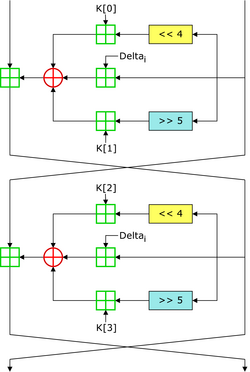 Two Feistel rounds (one cycle) of TEA[1] | |
| General | |
|---|---|
| Designers | Roger Needham, David Wheeler |
| First published | 1994 |
| Successors | XTEA |
| Cipher detail | |
| Key sizes | 128 bits |
| Block sizes | 64 bits |
| Structure | Feistel network |
| Rounds | variable; recommended 64 Feistel rounds (32 cycles) |
| Best public cryptanalysis | |
| TEA suffers from equivalent keys (see text; Kelsey et al., 1996) and can be broken using a related-key attack requiring 223 chosen plaintexts and a time complexity of 232.[2] The best structural cryptanalysis of TEA in the standard single secret key setting is the zero-correlation cryptanalysis breaking 21 rounds in 2121.5 time with less than the full code book [3] | |
In cryptography, the Tiny Encryption Algorithm (TEA) is a block cipher notable for its simplicity of description and implementation, typically a few lines of code. It was designed by David Wheeler and Roger Needham of the Cambridge Computer Laboratory; it was first presented at the Fast Software Encryption workshop in Leuven in 1994, and first published in the proceedings of that workshop.[4]
The cipher is not subject to any patents.
- ^ Matthew D. Russell (27 February 2004). "Tinyness: An Overview of TEA and Related Ciphers". Archived from the original on 12 August 2007.
- ^ Cite error: The named reference
kelsey1997was invoked but never defined (see the help page). - ^ Bogdanov, Andrey; Wang, Meiqin (2012). "Zero Correlation Linear Cryptanalysis with Reduced Data Complexity". Fast Software Encryption (PDF). Lecture Notes in Computer Science. Vol. 7549. pp. 29–48. doi:10.1007/978-3-642-34047-5_3. ISBN 978-3-642-34046-8.
- ^ Wheeler, David J.; Needham, Roger M. (16 December 1994). "TEA, a tiny encryption algorithm". Fast Software Encryption. Lecture Notes in Computer Science. Vol. 1008. Leuven, Belgium. pp. 363–366. doi:10.1007/3-540-60590-8_29. ISBN 978-3-540-60590-4.
{{cite book}}: CS1 maint: location missing publisher (link)